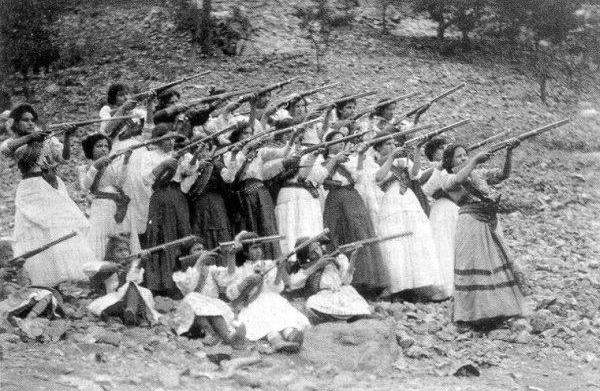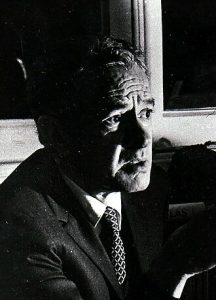Winner of the Spring 2018 StMU History Media Award for
Best Article in the Category of “Gender Studies”
“La Adelita” was one of the most popular corridos, or songs of romance, during the Mexican Revolution (1910-1920).1 This song is the love story of a young woman who travels with a sergeant and his regiment during the revolution.2 The song praises Adelita, the sweetheart of the troop, for both her beauty and her valor, noting how she is wanted by the other soldiers. We can imagine this woman as an object of desire, whose beauty and physique attracted the soldiers, and eventually broke their hearts. But this description is actually… incorrect.3
The Adelita, also known as soldadera, or female soldier, is the term used to describe women who contributed to many aspects of the Mexican Revolution. These women worked as nurses, food providers, lovers, spies, messengers, and fighters.4 In fact, some reached the rank of colonel and general. Many of them were forced by their husbands to follow them and work in the camps, but there were also those who volunteered to join the cause.5 Today, soldaderas are remembered as strong and courageous women who took up weapons and became fighters, often having to cut their hair and dress to appear like their male counterparts, because of the oppressive gender inequality prevalent in the Mexican society of that time.6 There is one soldadera in particular, Petra Herrera, also known as La Guerrera, and as La Generala (female general), who joined the cause and fought with the strongest of the soldiers. But what inspired women to join their male counterparts to fight this war, and why did the revolution even happen?

To answer this question and to be able to understand why these women now make up a very important aspect of Mexico’s history and its formation as a country, we need to go back in time to 1876, when the general and politician Porfirio Díaz became president. Porfirio Díaz was known to be a corrupt, elitist president, who favored wealthy landowners, industrialists, and foreign interests.7 The country was also known for the slave-like conditions rural people faced while working on the haciendas owned by wealthy landowners.8 These rural workers were very dissatisfied with the lack of voice they had in the government. But the precipitating event that sparked the revolution was Díaz’s announcement, in 1908, that he would run for his seventh term as president in 1910. This caused controversy among the people who had been suffering from his long regime. Francisco I. Madero then rose as the leader of the Antireeleccionistas (Anti-Reelection alliance). Madero subsequently announced that he would be running for president against Díaz. This prompted the mobilization of armies throughout Mexico. Countless leaders, such as Pascual Orozco and Pancho Villa, began raiding government garrisons as part of an uprising to remove the current president and eventually, elect a new president for the country.9 These were some of the events that inspired and sparked the courage of not only men but of women as well, to join the armies and fight for the shared goal of overthrowing Díaz’ dictatorship and make democracy in Mexico a reality.10

Petra Herrera witnessed the suffering of her country and decided to take action. She witnessed the harshness of landowners and the terrible conditions in which workers lived. She knew that the government had to change from being a corrupt one to being a democratic and fair one. But how would she help? Women at that time faced strict social prohibitions that kept them from playing important roles in the workforce. Instead, they were expected to be caregivers, stay at home, and take care of their children. Women were seen as precious and delicate, something that could not blend with the harshness of war. Petra, instead of following that norm, disguised herself as a man and started calling herself “Pedro Herrera” in order to join the revolutionary troops of Pancho Villa.11
During her time in the camp, she had to lie to her fellow soldiers in order to protect her identity. For example, she would lie that she shaved at dawn before the other soldiers woke up.12 Because of this, “Pedro” was able to blend in perfectly. Quickly after her joining the army, Petra was recognized as an aggressive fighter who carried out military operations efficiently and strategically. In disguise, she came to be known as a courageous and brave soldier, and was soon praised for her intelligence and her skills at blowing up bridges.

Thanks to the acknowledgment she faced on behalf of her peers and her establishment as a strong soldier, Petra decided she would confess her true identity. She believed this would not affect her position or status in the militia, and that she would be accepted and even promoted to general. But sadly, when she told the truth, she was removed from the army instead.13 Consequently, she decided to organize a group of women who were likewise removed from combat, even after they had fought courageously for the same cause as their male counterparts. Petra decided not to give up, and she organized a group of more than four hundred women with the same motive: to put an end to the current presidency and the hardships that Díaz had imposed on the citizens. Her militia not only fought in several battles, but Petra united these fighting women with Pancho Villas’ forces, despite his denial of them fighting and bearing arms. Together, they were able to take the city of Torreón on May 30, 1914, which had been a military base for Díaz’s central federation.14 At the end of the fight, she requested General Castro, a leader of the revolution, to allow her to re-enter the military and make her general, but he only granted her the title of colonel and disbanded her woman’s brigade.15 But her work did not end there. After the demobilization of the woman’s militia, Petra decided to join Venustiano Carranza, one of the main political leaders of the revolution who later became president of Mexico. She became a spy for him and worked as a bartender in Jimenez, a city in the northern part of Mexico.16 But while she was working there, she was shot three times by a group of drunk men, later dying from the injuries.
Despite the effort and the work Petra Herrera gave for the revolution, she has barely received any acknowledgment as a soldadera. There are several causes for this. Men during those times had mixed feelings about women being in combat and the role they had in the fight.17 One of the most passionate opponents of women joining the militia and bearing arms was Pancho Villa. He viewed women as liabilities to an army’s offensive strategy and combative potential, even though Petra Herrera and other great female combatants fought at his side several times to free the country from the oppressive presidency.18 There was also the idea that soldaderas were just images of romance during the Mexican Revolution, such as the song of “The Adelita,” contributing to recognizing only a few of them as strong fighters and contributions to this era.19 These women should be acknowledged and we should grant them a higher praise because many were forced to take this role of soldaderas after being abducted and often raped by revolutionaries who invaded their towns and cities. At the end of the day, the labor and effort of women such as Petra were very important factors for what we have come to know as the Mexican Revolution.
Hear the ballad of La Adelita
La Adelita
Spanish20
Little Adela
English translation21
- Beatriz de León, “La Adelita: El Rostro de La Soldadera,” in Reforma (Mexico D.F., Mexico), 2010. ↵
- Beatriz de León, “La Adelita: El Rostro de La Soldadera,” Reforma (Mexico D.F., Mexico), 2010. ↵
- Andrés Reséndez Fuentes, “Battleground Women: Soldaderas and Female Soldiers in the Mexican Revolution,” The Americas, no. 4, (1995): 55-57. ↵
- Oxford Research Encyclopedias, May 9, 2016, s.v. “Working Women in the Mexican Revolution,” by Susie S. Porter. ↵
- Donna Seaman, “Las Soldaderas: Women of the Mexican Revolution,” Booklist 103, no. 12, (2007): 18. ↵
- Elizabeth Salas, Soldaderas in the Mexican Military: Myth and History (Austin, Tex.: University of Texas Press, 1990), 48-49. ↵
- Encyclopedia Britannica, October 25, 2017, s.v. “Mexico | History, Geography, Facts, & Points of Interest – The Mexican Revolution and Its Aftermath.” ↵
- Encyclopedia Britannica, January 2, 2018, s.v. “Mexican Revolution | Causes, Summary, & Facts.” ↵
- Encyclopedia Britannica, January 2, 2018, s.v. “Mexican Revolution | Causes, Summary, & Facts.” ↵
- Encyclopedia of Latin American History and Culture, January 2008 v.s. “Women,” by Francesca Miller and Meredith Glueck. ↵
- Delia Fernandez, “‘La Adelita’ Becomes an Archetype of the Mexican Revolution,” McNair Scholar Journal, Vol. 13, (2009): 57-58. ↵
- Jason Porath, Rejected Princesses: Tales of History’s Boldest Heroines, Hellions, and Heretics, (New York, NY.: Patreon, 2016), 123-124. ↵
- Elena Poniatowska, Las soldaderas: women of the Mexican revolution (El Paso: Cinco Punto Press, 2006), 45. ↵
- Encyclopedia Britannica, October 25, 2017, s.v. “Mexico | History, Geography, Facts, & Points of Interest – The Mexican Revolution and Its Aftermath.” ↵
- Jason Porath, Rejected Princesses: Tales of History’s Boldest Heroines, Hellions, and Heretics, (New York, NY.: Patreon, 2016), 123-124. ↵
- Jason Porath, Rejected Princesses: Tales of History’s Boldest Heroines, Hellions, and Heretics, (New York, NY.: Patreon, 2016), 123-124. ↵
- Wilma Mankiller, Marysa Navarro, and Gloria Steinem, “Feminism and Feminisms: Feminism,” in Reader’s Companion to U.S. Women’s History (Boston, 1998), 187. ↵
- Oxford Research Encyclopedias, May 9, 2016, s.v. “Working Women in the Mexican Revolution,” by Susie S. Porter. ↵
- Alicia Arrizón, “Soldaderas and the Staging of the Mexican Revolution,” TDR: The Drama Review 42, no. 1, (1998): 105–107. ↵
- Amparo Ochoa, “La Adelita,” Corridos Y Canciones de la Revolucion Mexicana, Ediciones Pentagrama, 1995. Featured in video “La Adelita – Amparo Ochoa,” Courtesy of Youtube (https://www.youtube.com/watch?time_continue=64&v=hlGtOv-QEQQ ). ↵
- “La Adelita,” Mexican Folk Song, translation of last three stanzas by phantasmagoria ↵




127 comments
Fatima Navarro
What an icon, Petra was. I enjoy these stories that tell the story of women who fought and were pivotal in many battles back in the day, when women were not allow to be nothing else but the housewives who took care of their husband and the house. Many stories of strong women were untold and buried because only men were allowed to be given recognition. Therefore, it shouldn’t be forgotten that many females took part in battles as well and they, just as men, were key in the winning of them.
Danielle Slaughter
I had never heard of Petra Herrera. In fact, the only mention I had ever heard of “las Adelitas” was in the movie “The Book of Life”, wherein the main character meets his two “Adelita cousins” who fought in the revolution. Up to this point, I always thought it was just a surname. Never would I have expected to read such a captivating story about this courageous group of fighting women. How amazing was Señora Herrera, who defied the rules and expectations of a Mexican woman during her time. I believe I have found a new historical role model!
Michael Hinojosa
Thank you so much for being the one to share the story of Petra Herrera. Prior to reading this article I was completely and totally unaware of her existence and the services she’d done during her time on this world. I also liked the inclusion of the song lyrics, especially since the lyrics were in both Spanish and English, able to accommodate readers on both sides of the language spectrum!
Maria Martinez
Wow, this article really taught me a lot about my ancestors history that I had never even heard about. While the fact that Pancho Villa was one of the greatest obstacles that the soldareras faced considering he was so passionate about fighting for liberation, the story of Petra Herrera is amazing and it is a bit sad that there were around 600 strong women who fought alongside her who haven’t received the recognition they so rightfully deserve. I think that the story of these women really goes to show that the discrimination against women is rooted deep in our culture and that there is still a lot of work to be done towards complete gender equality in Mexico to this day, especially when dealing with machismo culture.
Gabriel Cohen
Great article, and I agree wholeheartedly with Mario about the accessibility issue of English and Spanish translations. These stories of heroics during times of struggle are often very romantic and imaginative, so I imagine it may have been difficult to tow the line between reality and fantasy when writing this. Stories like these are in many ways akin to popular imagination of the ‘universal soldier’, and show up all over the world. After World War II in Russia, the Soviets commemorated the fallen soldiers of the war as a single entity, and dedicated a tomb to them with the enscription “Your name is unknown, your deed is immortal.” Stories like these are widespread and often in the wind, but your choice of story and the way in which you wrote it really made the subject real. Great job!
Sara Ramirez
The lack of recognition for the Adelitas, or soldaderas of the Mexican Revolution is deeply upsetting. One of the most egregious examples being that Pancho Villa was one of the biggest opponents of the Adelitas, even as they fought and died by his side. As a Public History student, much of my studies focus on uncovering the hidden histories and giving a spotlight to those forgotten heroes. Thank you for recognizing Petra Herrera and the other courageous Adelitas through your wonderful article.
Edgar Velazquez Reynald
I’m very excited to have read this article. I wasn’t aware of Petra Herrera, but will now seek as much information about her as I can. You have a great introduction that shows us, through “La Adelita” how much time and myth have forgotten who Petra Herrera was. The article then successfully deconstructs this image and shows us a very important hero of the Mexican Revolution.
Mario Sosa
Thank you for sharing Petra Herrera’s story, as I am sure that many of us, myself included, were unfamiliar with her. I also appreciate that you included the lyrics to “La Adelita” in both english and spanish. Her life was indeed exciting and courageous, fighting for what she believed in – which only makes it more unfortunate that she died at the hands of drunken men outside the line of duty. Good job on the article!
John Cadena
Having just completed chapter 2 of Jack Hart’s Story Craft, I found myself focusing on the five areas of structure which make up a stories arc as I read through this piece. In reading about revolutionary soldadera Petra Herrera, I found it extremely easy to recognize the crisis element of a narrative arch. Faced with the difficult decision of revealing her true identity, the author perfectly conveys the part of a narrative, “where everything hands the balance, where things could go either way.” (Hart 34)
John Cadena
Having just completed chapter 2 of Jack Hart’s Story Craft, I found myself focusing on the five areas of structure which make up a stories arc as I read through this piece. Perfect for this was being able to recognize the use of rising action in this article. The excellent method of chronologically connecting the mystery which would come later in the story. Without a doubt, the words of Ted Conover did not go astray in this article, when he said, “a narrative is when things go wrong.” (Hart, 34)